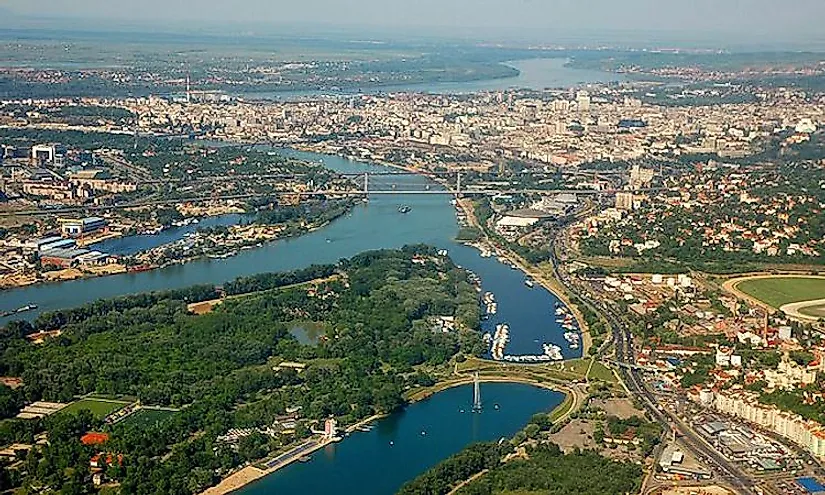Biggest Cities In Serbia

The country of Serbia is located in Southeastern Europe on the Balkan Peninsula. Serbia was part of the number of countries that made up the Communist Republic of Yugoslavia before it violently split apart in the 1990s. Today Serbia has a population of about 7.16 million people and about 25% of the country resides in the three largest cities of Serbia.
The Three Biggest Cities In Serbia
Belgrade
The capital city of Belgrade is the largest city in Serbia with a population of 1,344,844 people and is located in the City of Belgrade District. The city was inhabited by the Singi, a Thraco-Dacian tribe, before 279 BC when the Scordisci took over the place. In 75 BC the Romans conquered the area and controlled it until Attila Hun (c.406-453) sacked it in 442. Following this event, the city was conquered over the next millennium by the Ostrogoths, Gepids, Avars, the First Bulgarian Empire, the Byzantine Empire, the Kingdom of Hungary (1000-1918) and the Serbian Despotate (1402-1459). In 1521, the Ottoman Empire (1299-1923) took control of the city. Between then and 1804, the city switched hands between the Ottomans and Austrians seven times. In 1867, Belgrade became a part of Serbia when they gained de facto independence from the Ottomans. Belgrade is the financial center of Serbia and greater Southern Europe and also serves as the main center of information technology in the country. The city is the cultural center of the country with it being host to many international cultural events, and it was the center of Yugoslav new wave music in the 1980s. Belgrade is home to the Belgrade Fortress which was built in 535 by the Byzantine Empire and the Stari Dvor which was built in 1884 and served as the royal residence of the Obrenović dynasty that ruled Serbia.
Novi Sad
The city of Novi Sad is the second largest in Serbia with a population of 277,522 people and is located in the South Bačka District. The city of Novi Sad was founded in 1694 when a group of Serbian merchants formed a colony across from the Petrovaradin fortress on the Danube River. The city was under Austrian rule from when it was founded until 1918. It served as an important manufacturing and trading center, as well as a focal point of Serbian culture for the period. Novi Sad is the economic center for the most fertile agricultural region in Serbia and also serves as the second biggest cultural center in Serbia. The city is the home to the several major banks, the third largest insurance company in the country and is home to one of the largest oil companies and gas companies. Some of the notable sites in Novi Sad are the Serbian National Theatre, which was founded in 1861 and is the oldest professional theater in the South Slavs region. The city is also home to the Matica srpska which was founded in 1826, moved to Novi Sad in 1864 and is the oldest cultural-scientific institution in the country. There is also the aforementioned Petrovaradin fortress, which was finally finished in 1780 and today the Museum of Novi Sad is located in the fortress.
Niš
The city of Niš is the third largest in Serbia with a population of 260,237 people. It sits along the Nišava River in the Nišava District. Niš is one of the oldest cities in the Balkans, having been founded in 279 BC by the Gallic Iron Age tribe the Scordisci. In 75 BC, the Romans conquered the city as part of the Dardanian War (75–73 BC). The town was then mostly held by the Byzantine Empire (330-1453), until 987 when the First Bulgarian Empire (681-1018) annexed the city. The Byzantine's retook control of the city in the 11th century before giving it to the Serbs at some point in the 12 century. During the 15th century, the Ottomans captured the city and held it until 1878 when the Serbians liberated it towards the end of the Serbian–Ottoman War (1876–1878). The city of Niš is an important center for industry in Serbia, especially for electronics, mechanical engineering, textile and tobacco and is located at an important intersection connecting European highway and railway networks with Asia. Some of the city's notable attractions include the Imperial Villa of Mediana from the late Roman period, the Skull Tower which was built in 1809 as a monument to the Serbian revolutionaries (1804–17) and the Niš Fortress which was built by the Turks at some point around 1720.
The Future Of Serbia's Population
The country of Serbia today has a population of about 7.1 million people, but Serbia's population has been slowly declining in the last decade. According to a report last year from the United Nations (UN), Serbia is projected to lose 17% of its population by 2050.
Biggest Cities In Serbia
| Rank | Most Populous Urban Areas in Serbia | Population |
| 1 | Belgrade | 1,344,844 |
| 2 | Novi Sad | 277,522 |
| 3 | Niš | 260,237 |
| 4 | Kragujevac | 150,835 |
| 5 | Kraljevo | 125,488 |
| 6 | Čačak | 123,414 |
| 7 | Zrenjanin-Pančevo | 120,709 |
| 8 | Smederevo | 108,209 |
| 9 | Subotica | 105,681 |
| 10 | Novi Pazar | 100,410 |











